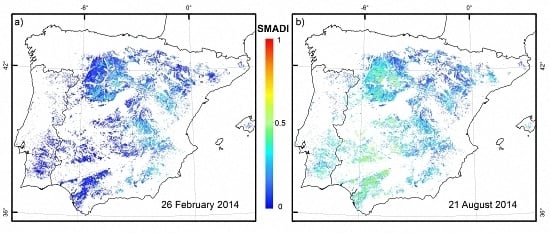A New Soil Moisture Agricultural Drought Index (SMADI) Integrating MODIS and SMOS Products: A Case of Study over the Iberian Peninsula
Abstract
:1. Introduction
2. Methods
2.1. Satellite Data Processing
2.1.1. MODIS LST, NDVI and NDWI
2.1.2. SMOS
2.2. Index Rationale
2.3. Climatic Conditions and Validation Strategies
3. Results and Discussion
3.1. Evaluation at the REMEDHUS Area
3.2. Evaluation over the Iberian Peninsula
3.3. Functional Definition of Drought Using SMADI as Indicator
4. Conclusions
Acknowledgments
Author Contributions
Conflicts of Interest
References
- Moreira, E.E.; Mexia, J.T.; Pereira, L.S. Are drought occurrence and severity aggravating? A study on SPI drought class transitions using log-linear models and ANOVA-like inference. Hydrol. Earth Syst. Sci. Discuss. 2012, 16, 3011–3028. [Google Scholar] [CrossRef]
- Park, S.; Feddema, J.J.; Egbert, S.L. Impacts of hydrologic soil properties on drought detection with MODIS thermal data. Remote Sens. Environ. 2004, 89, 53–62. [Google Scholar] [CrossRef]
- Szép, I.J.; Mika, J.; Dunkel, J. Palmer drought severity index as soil moisture indicator: Physical interpretation, statistical behaviour and relation to global climate. Phys. Chem. Earth 2005, 30, 231–243. [Google Scholar] [CrossRef]
- Wilhite, D.A.; Glantz, M.H. Understanding the drought phenomenon: The role of definitions. Water Int. 1985, 10, 111–120. [Google Scholar] [CrossRef]
- Senay, G.B.; Budde, M.B.; Brown, J.F.; Verdin, J.P. Mapping flash drought in the U.S. Southern great plains. In Proceedings of the 22nd Conference on Hydrology, New Orleans, LA, USA, 20–24 January 2008.
- Hunt, E.D.; Hubbard, K.G.; Wilhite, D.A.; Arkebauer, T.J.; Dutcher, A.L. The development and evaluation of a soil moisture index. Int. J. Climatol. 2009, 29, 747–759. [Google Scholar] [CrossRef]
- McKee, T.B.; Doesken, N.J.; Kleist, J. The relationship of drought frequency and duration of time scales. In Proceedings of the Eighth Conference on Applied Climatology, Anaheim, CA, USA, 17–23 January 1993; pp. 179–186.
- Palmer, W.C. Meteorological Drought; Research Paper No. 45; Bureau, U.S.W., Ed.; NOAA Library and Information Services Division: Washington, DC, USA, 1965.
- Palmer, W.C. Keeping track of crop moisture conditions, nationwide: The new crop moisture index. Weatherwise 1968, 21, 156–161. [Google Scholar] [CrossRef]
- Wan, Z.; Wangab, P.; Lib, X. Using MODIS Land Surface Temperature and Normalized Difference Vegetation Index products for monitoring drought in the southern Great Plains, USA. Int. J. Remote Sens. 2004, 25, 61–72. [Google Scholar] [CrossRef]
- Ochsner, T.E.; Cosh, M.; Cuenca, R.H.; Dorigo, W.A.; Draper, C.S.; Hagimoto, Y.; Kerr, Y.; Njoku, E.G.; Small, E.E.; Zreda, M. State of the art in large-scale soil moisture monitoring. Soil Sci. Soc. Am. J. 2013, 77, 1888–1919. [Google Scholar] [CrossRef] [Green Version]
- Martínez-Fernández, J.; González-Zamora, A.; Sánchez, N.; Gumuzzio, A. A soil water based index as a suitable agricultural drought indicator. J. Hydrol. 2015, 522, 265–273. [Google Scholar] [CrossRef]
- Kerr, Y.; Waldteufel, P.; Wigneron, J.P.; Delwart, S.; Cabot, F.; Boutin, J.; Escorihuela, M.J.; Font, J.; Reul, N.; Gruhier, C.; et al. The SMOS MISSION: New tool for monitoring key elements of the Global Water Cycle. Proc. IEEE 2010, 98, 666–687. [Google Scholar] [CrossRef] [Green Version]
- Entekhabi, D.; Njoku, E.; O’Neill, P.E.; Kellogg, K.H.; Crow, W.T.; Edelstein, W.N.; Entin, J.K.; Goodman, S.D.; Jackson, T.; Johnson, J.; et al. The Soil Moisture Active Passive (SMAP) mission. Proc. IEEE 2010, 98, 704–716. [Google Scholar] [CrossRef]
- Chakrabarti, S.; Bongiovanni, T.; Judge, J.; Zotarelli, L.; Bayer, C. Assimilation of SMOS soil moisture for quantifying drought impacts on crop yield in agricultural regions. IEEE J. Sel. Top. Appl. Earth Obs. Remote Sens. 2014, 7, 3867–3879. [Google Scholar] [CrossRef]
- Carlson, T. Triangle models and misconceptions. Int. J. Remote Sens. Appl. 2013, 3, 155–158. [Google Scholar]
- Sánchez, N.; Martínez-Fernández, J.; Piles, M.; Camps, A.; Vall-llossera, M.; Aguasca, A. Hyperspectral-derived indices for soil moisture estimation at very high resolution. In Proceedings of the IEEE International Geoscience and Remote Sensing Symposium, IGARSS 2014, Québec, QC, Canada, 13–18 July 2014; pp. 2898–2901.
- Piles, M.; Sánchez, N.; Vall-llossera, M.; Camps, A.; Martínez-Fernández, J.; Martínez, J.; González-Gambau, V. A dowscaling approach for SMOS land observations: Evaluation of high resolution soil moisture maps over the Iberian Peninsula. IEEE J. Sel. Top. Appl. Earth Obs. Remote Sens. 2014, 7, 3845–3857. [Google Scholar] [CrossRef]
- Merlin, O.; Escorihuela, M.J.; Mayoral, M.A.; Hagolle, O.; Albitar, A.; Kerr, Y. Self-calibrated evaporation-based disaggregation of SMOS soil moisture: An evaluation study at 3 km and 100 m resolution in Catalunya, Spain. Remote Sens. Environ. 2013, 130, 25–38. [Google Scholar] [CrossRef] [Green Version]
- Thenkabail, P.S.; Gamage, M.S.D.N.; Smakhtin, V.U. The Use of Remote Sensing Data for Drought Assessment and Monitoring in Southwest Asia; International Water Management Institute: Colombo, Sri Lanka, 2004; p. 34. [Google Scholar]
- Reed, B.C. Using remote sensing and Geographic Information Systems for analyzing landscape/drought interaction. Int. J. Remote Sens. 1993, 14, 3489–3503. [Google Scholar] [CrossRef]
- Rundquist, B.C.; Harrington, J.A., Jr. The effects of climatic factors on vegetation dynamics of tallgrass and shortgrass cover. GeoCarto Int. 2000, 15, 31–36. [Google Scholar] [CrossRef]
- Wang, J.; Price, K.P.; Rich, P.M. Spatial patterns of NDVI in response to precipitation and temperature in the central Great Plains. Int. J. Remote Sens. 2001, 22, 3827–3844. [Google Scholar] [CrossRef]
- Farrar, T.J.; Nicholson, S.E.; Lare, A.R. The influence of soil type on the relationships between NDVI, rainfall and soil moisture in semiarid Botswana. II. NDVI response to soil moisture. Remote Sens. Environ. 1994, 50, 121–133. [Google Scholar] [CrossRef]
- Tucker, C.J.; Choudhury, B.J. Satellite remote sensing of drought conditions. Remote Sens. Environ. 1987, 23, 243–251. [Google Scholar] [CrossRef]
- Bayarjargal, Y.; Karnieli, A.; Bayasgalan, M.; Khudulmur, S.; Gandush, C.; Tucker, C.J. A comparative study of NOAA-AVHRR derived drought indices using change vector analysis. Remote Sens. Environ. 2006, 105, 9–22. [Google Scholar] [CrossRef]
- Bhuiyan, C.; Singh, R.P.; Kogan, F.N. Monitoring drought dynamics in the Aravalli region (India) using different indices based on ground and remote sensing data. Int. J. Appl. Earth Obs. Geoinf. 2006, 8, 289–302. [Google Scholar] [CrossRef]
- Kogan, F.N. Global drought watch from space. Bull. Am. Meteorol. Soc. 1997, 78, 621–636. [Google Scholar] [CrossRef]
- Hayes, M.J.; Decker, W.L. Using satellite and real-time weather data to predict maize production. Int. J. Biometeorol. 1998, 42, 10–15. [Google Scholar] [CrossRef]
- Kogan, F.N. Remote sensing of weather impacts on vegetation in nonhomogeneous areas. Int. J. Remote Sens. 1990, 11, 1405–1419. [Google Scholar] [CrossRef]
- Peters, A.J.; Walter-Shea, E.A.; Ji, L.; Viña, A.; Hayes, M.; Svoboda, M.D. Drought Monitoring with NDVI-Based Standardized Vegetation Index. Photogramm. Eng. Remote Sens. 2002, 68, 71–75. [Google Scholar]
- Wilhite, D.A. Drought monitoring, mitigation and preparedness in the U.S.: An end to end approach. In Proceedings of the WMO Task Force on Social-Economic Application of Public Weather Services, Geneva, Switzerland, 15–18 May 2006.
- WMO. Monitoring, Assessment and Combat of Drought and Desertification; World Meteorological Organization: Geneva, Switzerland, 1992; p. 111. [Google Scholar]
- Sivakumar, M.V.K. Agricultural Drought-WMO Perspectives. In Agricultural Drought Indices, Proceedings of the WMO/UNISDR Expert Group Meeting on Agricultural Drought Indices, Murcia, Spain, 2–4 June 2010; Sivakumar, M.V.K., Motha, R.P., Wilhite, D.A., Wood, D.A., Eds.; World Meteorological Organization: Geneva, Switzerland, 2011; Volume 1572, pp. 22–34. [Google Scholar]
- Sánchez-Ruiz, S.; Piles, M.; Sánchez, N.; Martínez-Fernández, J.; Vall-llossera, M.; Camps, A. Combining SMOS with visible and near/shortwave/thermal infrared satellite data for high resolution soil moisture estimates. J. Hydrol. 2014, 516, 273–283. [Google Scholar] [CrossRef]
- Ji, L.; Peters, A.P. Assessing vegetation response to drought in the northern Great Plains using vegetation and drought indices. Remote Sens. Environ. 2003, 87, 85–98. [Google Scholar] [CrossRef]
- Whiting, M.L.; Li, L.; Ustin, S.L. Predicting water content using Gaussian model on soil spectra. Remote Sens. Environ. 2004, 89, 535–552. [Google Scholar] [CrossRef]
- Lobell, D.B.; Asner, G.P. Moisture effects on soil reflectance. Soil Sci. Soc. Am. J. 2002, 66, 722–727. [Google Scholar] [CrossRef]
- Ezzine, H.; Bouziane, A.; Ouazar, D. Seasonal comparisons of meteorological and agricultural droughtindices in Morocco using open short time-series data. Int. J. Appl. Earth Obs. Geoinf. 2014, 26, 36–48. [Google Scholar] [CrossRef]
- Rouse, J.W.; Haas, R.H.; Shell, J.A.; Deering, D.W.; Harlan, J.C. Monitoring the Vernal Advancement of Retrogradation of Natural Vegetation; Final Report, Type III; NASA/GSFC: Greenbelt, MD, USA, 1974; p. 371.
- Gao, B. NDWI-A Normalized Difference Water Index for remote sensing of vegetation liquid water from space. Remote Sens. Environ. 1996, 58, 257–266. [Google Scholar] [CrossRef]
- Ayars, J.E. Adapting irrigated agriculture to drought in the San Joaquin Valley of California. In Drought in Arid and Semi-Arid Regions; Schwabe, K., Albiac, J., Connor, J.D., Hassan, R.M., Meza González, L., Eds.; Springer Netherlands: Dordrecht, The Netherlands, 2013; pp. 25–39. [Google Scholar]
- AEMet. Iberian Climate Atlas, 1971–2000; Agencia Estatal de Meteorología, Ministerio de Medio Ambiente y Medio Rural y Marino, Instituto de Meteorologia de Portugal: Madrid, Spain, 2011; p. 80.
- Ninyerola, M.; Pons, X.; Roure, J.M. Atlas Climático Digital de la Península Ibérica. Metodología y Aplicaciones en Bioclimatología y Geobotánica; Universidad Autónoma de Barcelona: Barcelona, Spain, 2005. [Google Scholar]
- González-Zamora, A.; Sanchez, N.; Martínez-Fernández, J.; Gumuzzio, A.; Piles, M.; Olmedo, E. Long-term SMOS soil moisture products: A comprehensive evaluation across scales and methods in the Duero Basin (Spain). Phys. Chem. Earth 2015, 83–84, 123–136. [Google Scholar] [CrossRef]
- Kogan, F.N. Application of vegetation index and brightness temperature for drought detection. Adv. Space Res. 1995, 11, 91–100. [Google Scholar] [CrossRef]
- Kogan, F.N.; Usa, D.C.; Stark, R.; Gitelson, A.; Jargalsaikhan, L.; Dugarjav, C.; Tsoojd, S. Derivation of pasture biomass in Mongolia from AVHRRbased vegetation health indices. Int. J. Remote Sens. 2004, 25, 2889–2896. [Google Scholar] [CrossRef]
- Goetz, S.J. Multisensor analysis of NDVI, surface temperature and biophysical variables at a mixed grassland site. Int. J. Remote Sens. 1997, 18, 71–94. [Google Scholar] [CrossRef]
- Sandholt, I.; Rasmussen, K.; Andersen, J. A simple interpretation of the surface temperature/vegetation index space for assessment of surface moisture status. Remote Sens. Environ. 2002, 79, 213–224. [Google Scholar] [CrossRef]
- Karnieli, A.; Agam, N.; Pinker, R.T.; Anderson, M.; Imhoff, M.L.; Gutman, G.G.; Panov, N.; Goldberg, A. Use of NDVI and land surface temperature for drought assessment: Merits and limitations. J. Clim. 2010, 23, 618–633. [Google Scholar] [CrossRef]
- McVicar, T.R.; Bierwirth, P.N. Rapidly assessing 1997 drought in Papua New Guinea using composite AHVRR imagery. Int. J. Remote Sens. 2001, 22, 2109–2128. [Google Scholar] [CrossRef]
- Nemani, R.R.; Pierce, L.; Running, S.W.; Goward, S.N. Developing satellite-derived estimates of surface moisture status. J. Appl. Meteorol. 1993, 32, 548–557. [Google Scholar] [CrossRef]
- Di, L.; Rundquist, B.C.; Han, L. Modeling relationship between NDVI and precipitation during vegetative growth cycles. Int. J. Remote Sens. 1994, 15, 2121–2136. [Google Scholar] [CrossRef]
- Zhang, F.; Zhang, L.W.; Wang, X.Z.; Hung, J.F. Detecting agro-droughts in Southwest of China using MODIS satellite data. J. Integr. Agric. 2013, 12, 159–168. [Google Scholar] [CrossRef]
- Anderson, W.B.; Zaitchik, B.F.; Hain, C.R.; Anderson, M.C.; Yilmaz, M.T.; Mecikalski, J.; Schultz, L. Towards an integrated soil moisture drought monitor for East Africa. Hydrol. Earth Syst. Sci. 2012, 16, 2893–2913. [Google Scholar] [CrossRef]
- Schnur, M.T.; Xie, H.; Wang, X. Estimating root zone soil moisture at distant sites using MODIS NDVI and EVI in a semi-arid region of southwestern USA. Ecol. Inform. 2010, 5, 400–409. [Google Scholar] [CrossRef]
- Li, R.; Tsunekawa, A.; Tsubo, M. Index-based assessment of agricultural drought in a semi-arid region of Inner Mongolia, China. J. Arid Land 2014, 6, 3–15. [Google Scholar] [CrossRef]
- Nghiem, S.V.; Wardlow, B.D.; Allured, D.; Svoboda, M.D.; LeComte, D.; Rosencrans, M.; Chan, S.K.; Neumann, G. Microwave Remote Sensing of Soil Moisture. In Remote Sensing of Drought: Innovative Monitoring Approaches; Wardlow, B.D., Anderson, M.C., Verdin, J.P., Eds.; CRC Press: Boca Raton, FL, USA, 2012; pp. 197–226. [Google Scholar]
- Higgins, R.W.; Shi, W.; Yarosh, E.; Joyce, R. Improved United States precipitation quality control system and analysis. In NCEP/Climate Prediction Center Atlas; Climate Prediction Center: Camp Springs, MD, USA, 2000; Volume 7, p. 40. [Google Scholar]
- WMO. Standardized Precipitation Index. User Guide; World Meteorological Organization: Geneva, Switzerland, 2012; p. 24. [Google Scholar]
- Wu, H.; Svoboda, M.D.; Hayes, M.J.; Wilhite, D.A.; Wen, F. Appropriate application of the Standardized Precipitation Index in arid locations and dry seasons. Int. J. Climatol. 2007, 27, 65–79. [Google Scholar] [CrossRef]
- EC-JCR; European Drought Observatory (EDO). Drought News 2014; European Drought Observatory: Ispra, Italy, 2014; p. 8. [Google Scholar]
- EC-JCR. Crop Monitoring in Europe; AGRI4CAST-JRC/IES MARS Unit: Luxembourg, 2014; p. 44. [Google Scholar]
- Gu, Y.; Brown, J.F.; Verdin, J.P.; Wardlow, B.D. A five-year analysis of MODIS NDVI and NDWI for grassland drought assessment over the central Great Plains of the United States. Geophys. Res. Lett. 2007, 34, L06407. [Google Scholar] [CrossRef]
- Scaini, A.; Sánchez, N.; Vicente-Serrano, S.M.; Martínez-Fernández, J. SMOS-derived soil moisture anomalies and drought indices: A comparative analysis using in situ measurements. Hydrol. Processes 2015, 29, 373–383. [Google Scholar] [CrossRef]
- Bhuiyan, C. Desert vegetation during droughts: Response and sensitivity. Int. Arch. Photogramm. Remote Sens. Spat. Inf. Sci. 2008, 21, 907–912. [Google Scholar]
- Martínez Fernández, J.; González- Zamora, A.; Sánchez, N.; Gumuzzio, A.; Herrero-Jiménez, C.M. Satellite soil moisture for agricultural drought monitoring: Assessment of the SMOS derived Soil Water Deficit Index. Remote Sens. Environ. 2016, 177, 277–286. [Google Scholar] [CrossRef]
- Kogan, F. Operational space technology for global vegetation assessment. Bull. Am. Meteorol. Soc. 2001, 82, 1949–1964. [Google Scholar] [CrossRef]
- Sivakumar, M.V.K.; Stone, R.; Sentelhas, P.C.; Svoboda, M.; Omondi, P.; Sarkar, J.; Wardlow, B. Agricultural drought indices: Summary and recommendations. In Agricultural Drought Indices, Proceedings of the WMO/UNISDR Expert Group Meeting on Agricultural Drought Indices, Murcia, Spain, 2–4 June 2010; Sivakumar, M.V.K., Motha, R.P., Wilhite, D.A., Wood, D.A., Eds.; World Meteorological Organization: Geneva, Switzerland, 2011; Volume 1572, pp. 172–194. [Google Scholar]
- Brown, J.F.; Wardlow, B.D.; Tadesse, T.; Hayes, M.J.; Reed, B.C. The Vegetation Drought Response Index (VegDRI): An integrated approach for monitoring drought stress in vegetation. GIScience Remote Sens. 2008, 45, 16–46. [Google Scholar] [CrossRef]
- NOAA-National Weather Service. Available online: http://www.cpc.ncep.noaa.gov/products/analysis_monitoring/cdus/palmer_drought/wpdanote.shtml (accessed on 18 October 2015).
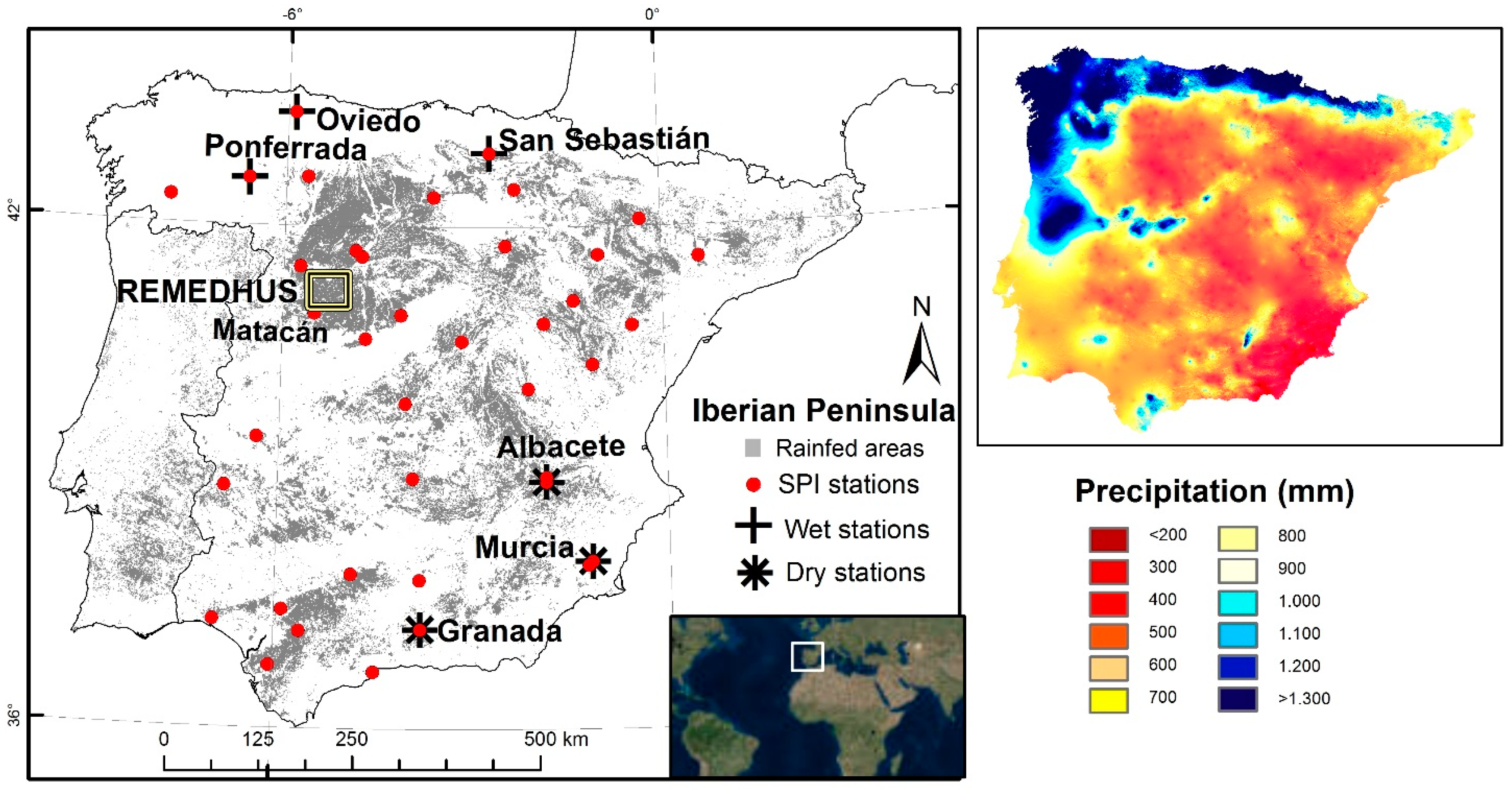
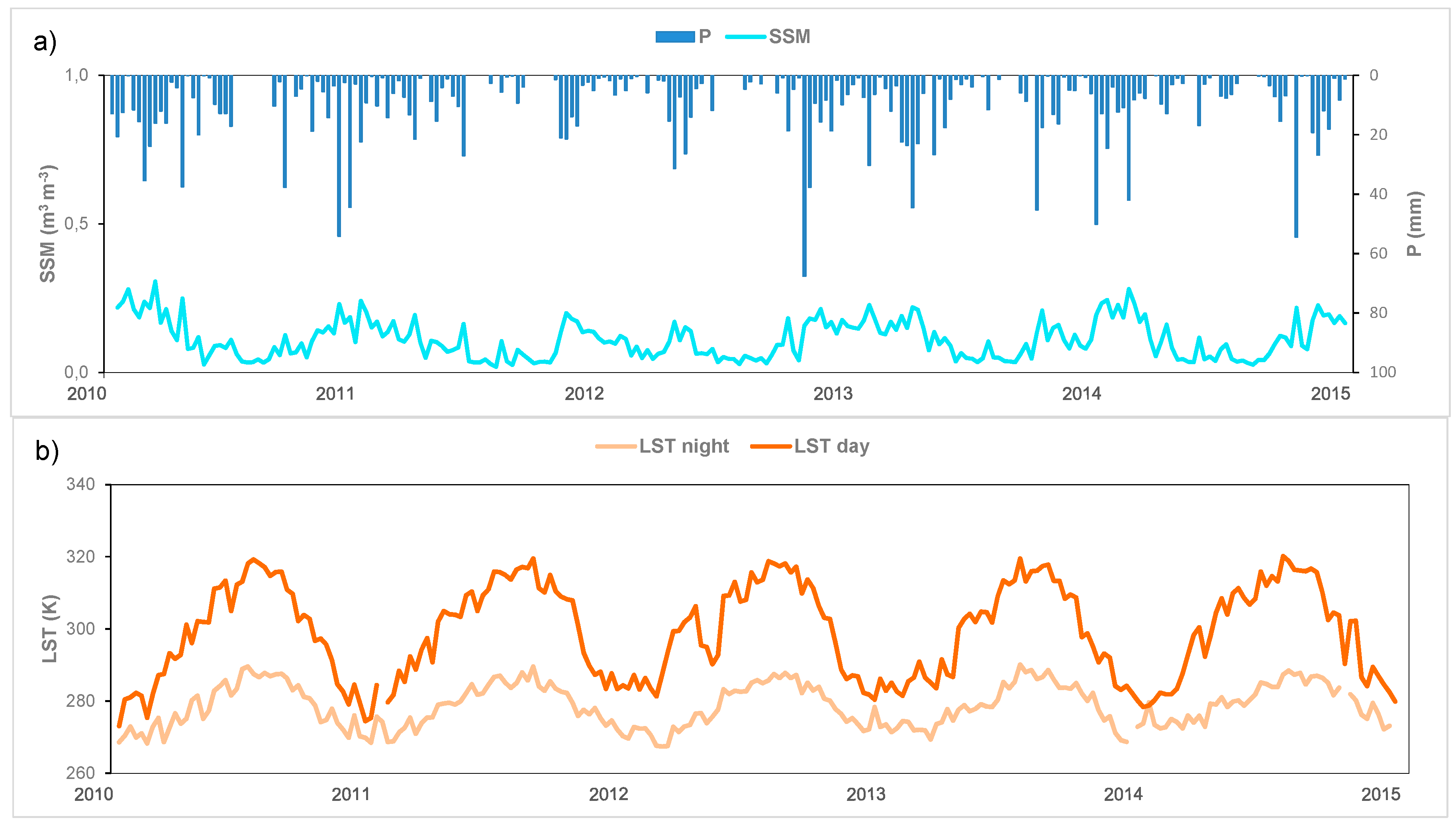




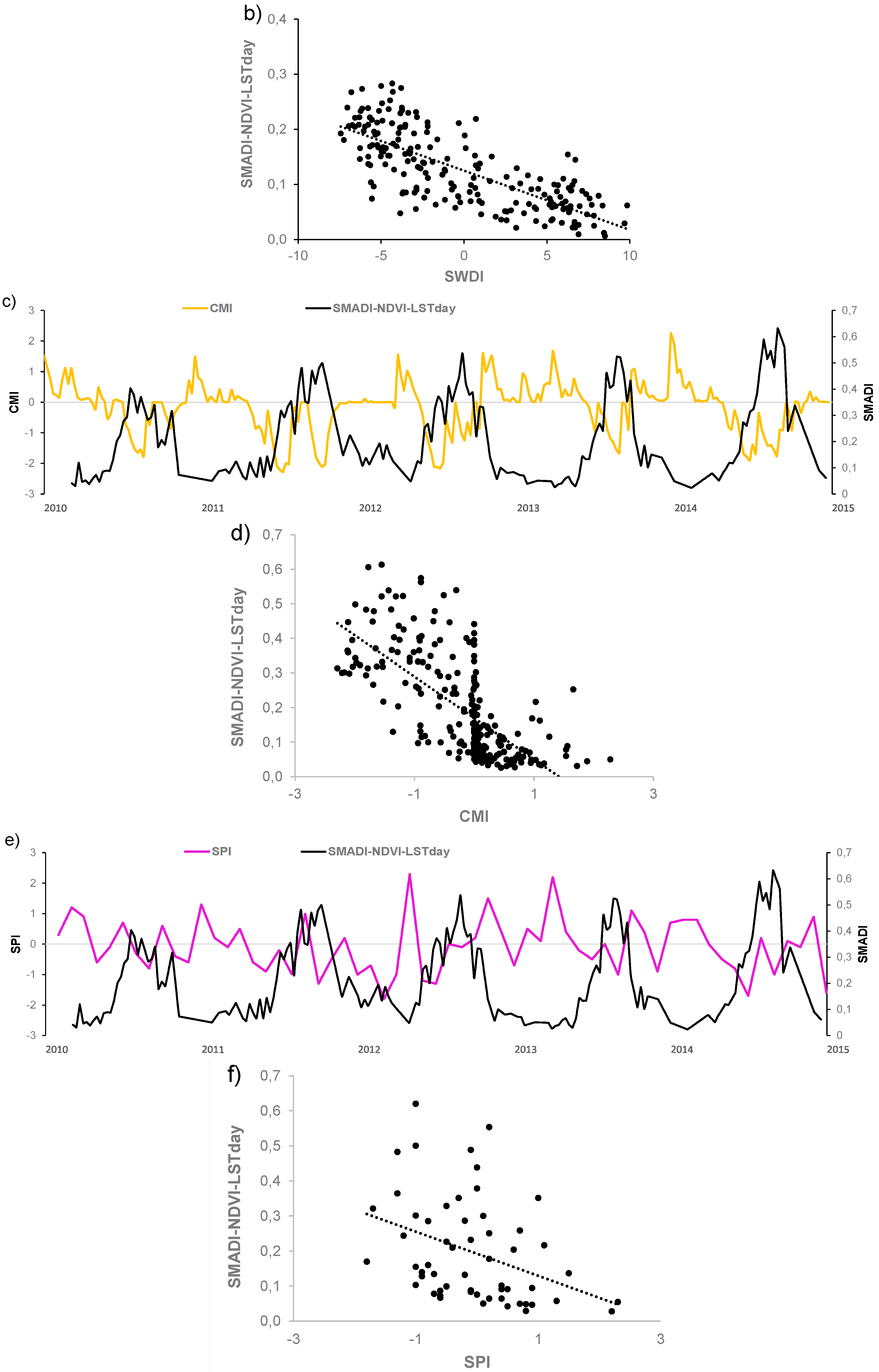
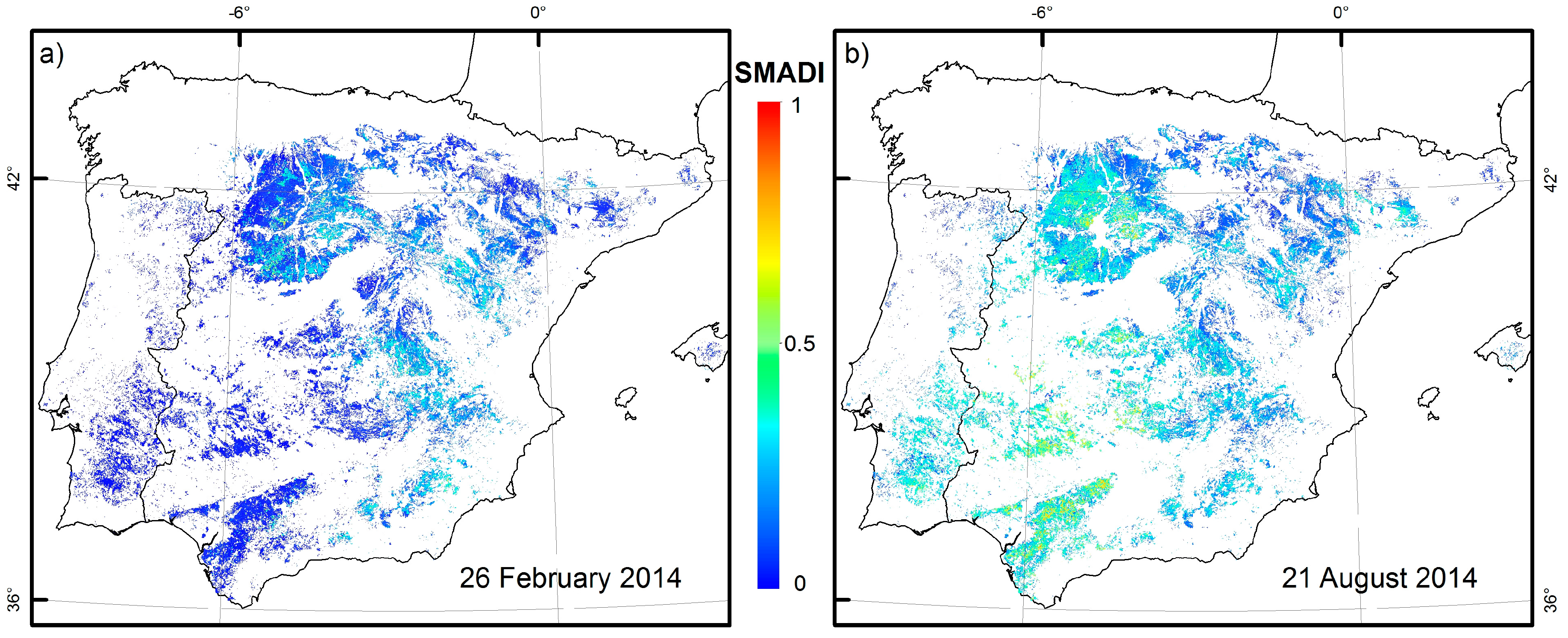

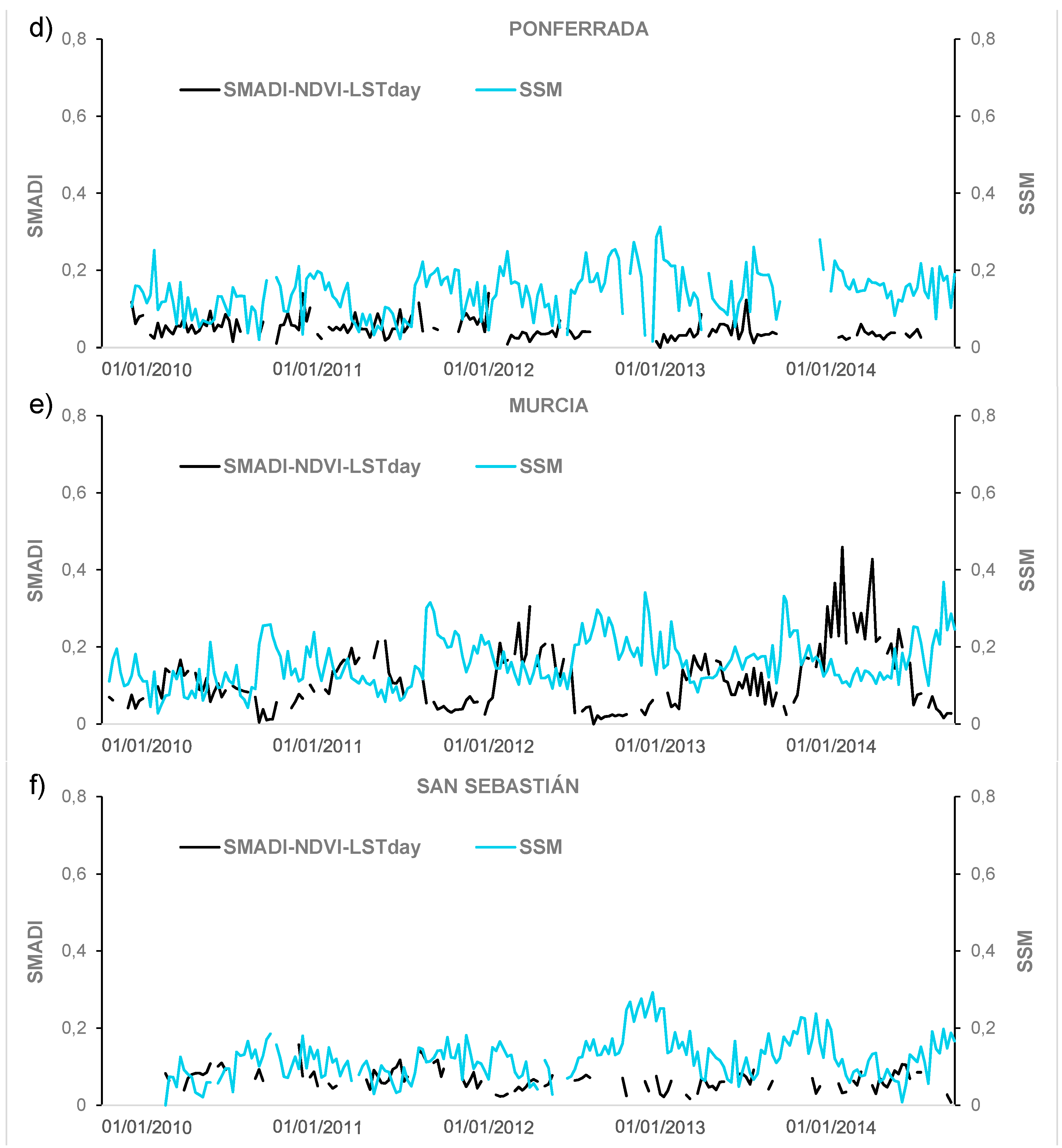


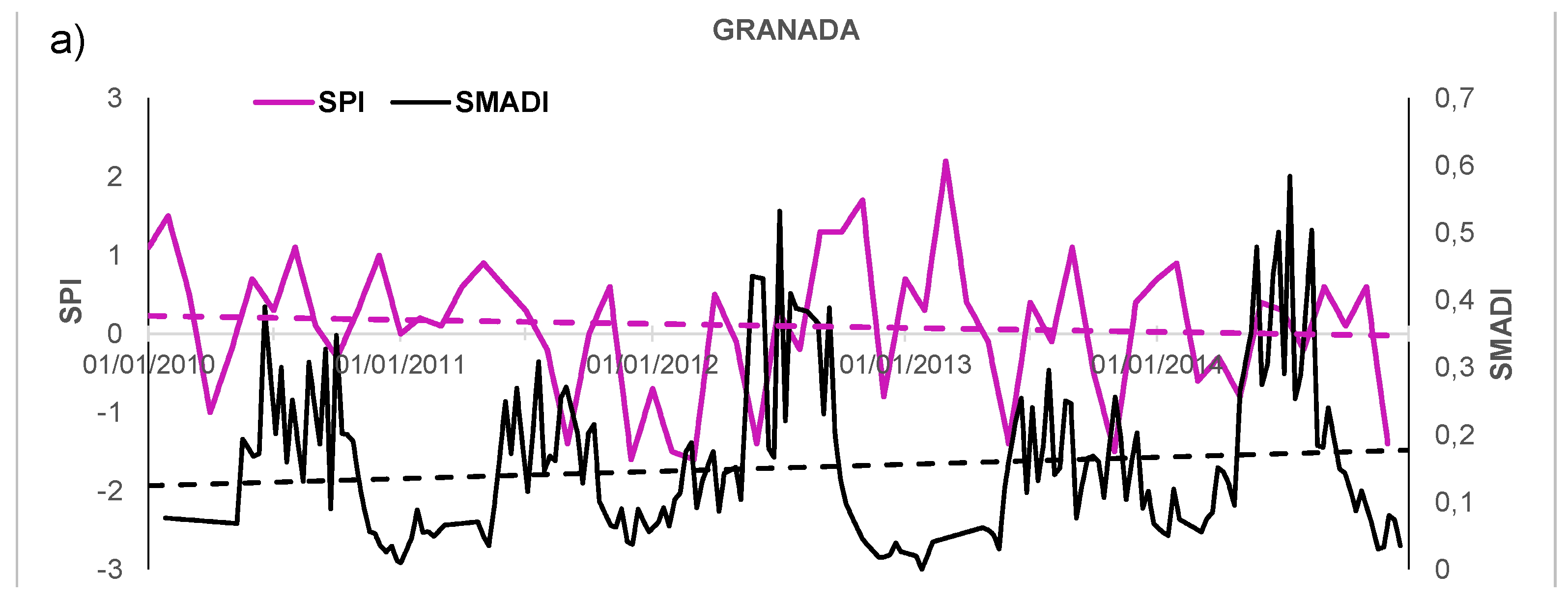
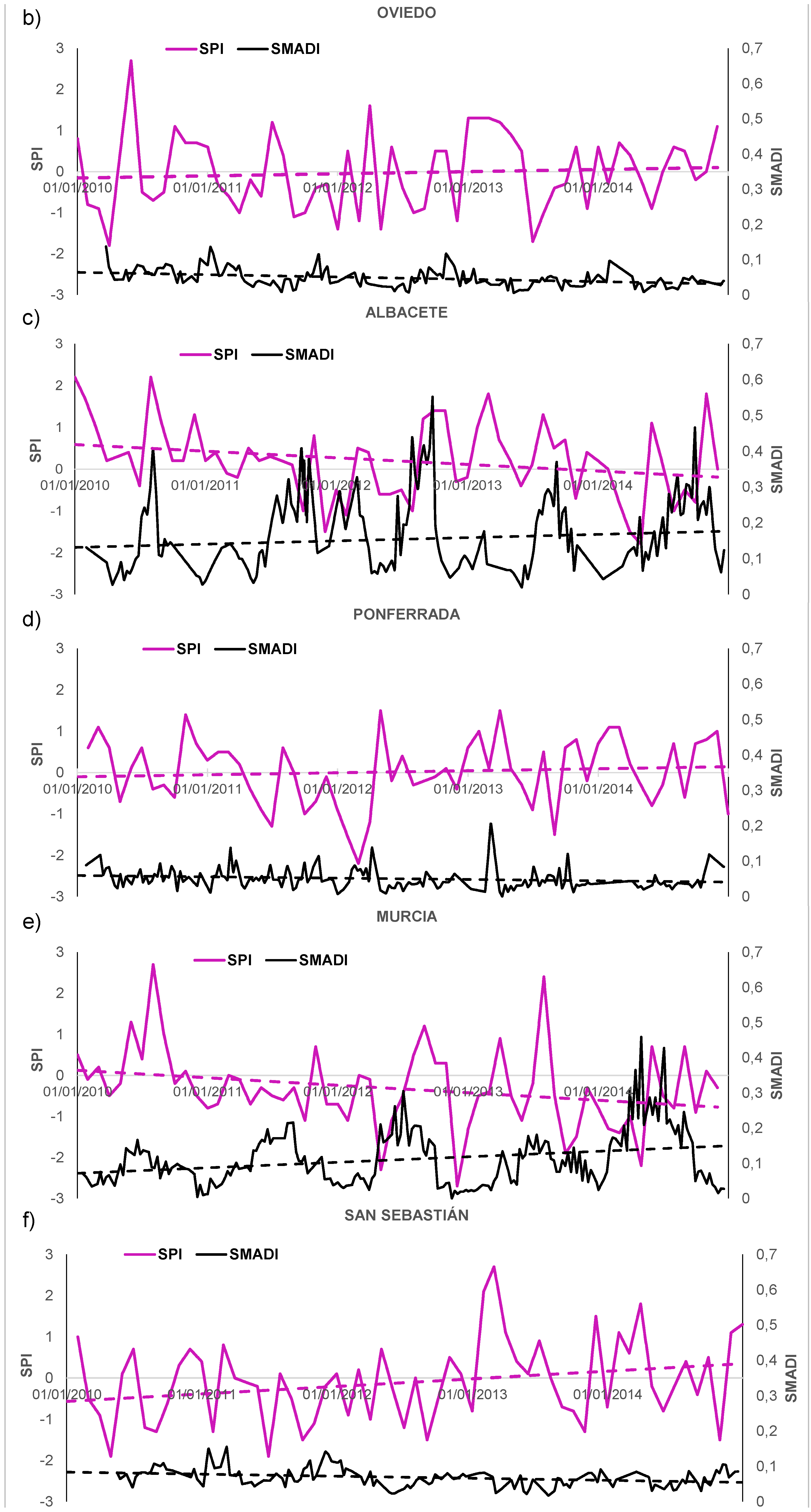

| R | SMADI-NDVI | SMADI-NDW1 | SMADI-NDW2 | SMADI-NDW3 | ||||
|---|---|---|---|---|---|---|---|---|
| LSTday | LSTnight | LSTday | LSTnight | LSTday | LSTnight | LSTday | LSTnight | |
| SWDI (REMEDHUS) | −0.75 | −0.72 | −0.57 | −0.53 | −0.66 | −0.60 | −0.53 | −0.53 |
| SWDI (REMEDHUS) 0 days lag | −0.71 | −0.66 | −0.45 | −0.48 | −0.58 | −0.57 | −0.50 | −0.40 |
| SWDI (REMEDHUS) 16 days lag | −0.75 | −0.68 | −0.49 | −0.47 | −0.66 | −0.60 | −0.56 | −0.45 |
| SWDI (REMEDHUS) 24 days lag | −0.68 | −0.65 | −0.40 | −0.50 | −0.65 | −0.62 | −0.54 | −0.47 |
| R | LSTday | LSTnight | NDVI | NDWI1 | NDWI2 | NDWI3 | SSM |
|---|---|---|---|---|---|---|---|
| SWDI (REMEDHUS) | −0.74 | −0.68 | 0.57 | 0.21 | 0.23 | 0.18 | 0.75 |
| CMI (Matacán) | −0.71 | −0.63 | 0.43 | 0.28 | 0.21 | 0.35 | 0.71 |
| SPI (Matacán) | −0.40 | −0.23 | 0.19 | 0.23 | 0.27 | 0.35 | 0.61 |
| R | SMADI-NDVI | SMADI-NDW1 | SMADI-NDW2 | SMADI-NDW3 | ||||
|---|---|---|---|---|---|---|---|---|
| LSTday | LSTnight | LSTday | LSTnight | LSTday | LSTnight | LSTday | LSTnight | |
| CMI (Matacán) | −0.71 | −0.69 | −0.44 | −0.45 | −0.33 | −0.34 | −0.36 | −0.39 |
| SPI (Matacán) | −0.37 | −0.33 | −0.41 | −0.25 | −0.26 | −0,19 | −0.28 | −0.22 |
| SWDI | CMI * | SPI ** | PDSI *** | SMADI | Description |
|---|---|---|---|---|---|
| 0 or more | 0.9 to −0.99 | 1 to −0.99 | −0.49 or more | 0 to 0.19 | Normal, near normal, non-drought |
| 0 to −1.99 | −1 to −1.99 | −0.5 to −1.99 | 0.20 to 0.39 | Abnormally dry, mild drought | |
| −2 to −4.99 | −2 to −2.99 | −1 to −1.49 | −2 to −2.99 | 0.40 to 0.59 | Moderate drought |
| −5 to −9.99 | −3 or less | −1.5 to −1.99 | −3 to −3.99 | 0.60 to 0.79 | Severe drought |
| −10 or less | −2 or less | −4 or less | 0.8 to 1 | Extreme drought |
© 2016 by the authors; licensee MDPI, Basel, Switzerland. This article is an open access article distributed under the terms and conditions of the Creative Commons by Attribution (CC-BY) license (http://creativecommons.org/licenses/by/4.0/).
Share and Cite
Sánchez, N.; González-Zamora, Á.; Piles, M.; Martínez-Fernández, J. A New Soil Moisture Agricultural Drought Index (SMADI) Integrating MODIS and SMOS Products: A Case of Study over the Iberian Peninsula. Remote Sens. 2016, 8, 287. https://doi.org/10.3390/rs8040287
Sánchez N, González-Zamora Á, Piles M, Martínez-Fernández J. A New Soil Moisture Agricultural Drought Index (SMADI) Integrating MODIS and SMOS Products: A Case of Study over the Iberian Peninsula. Remote Sensing. 2016; 8(4):287. https://doi.org/10.3390/rs8040287
Chicago/Turabian StyleSánchez, Nilda, Ángel González-Zamora, María Piles, and José Martínez-Fernández. 2016. "A New Soil Moisture Agricultural Drought Index (SMADI) Integrating MODIS and SMOS Products: A Case of Study over the Iberian Peninsula" Remote Sensing 8, no. 4: 287. https://doi.org/10.3390/rs8040287






